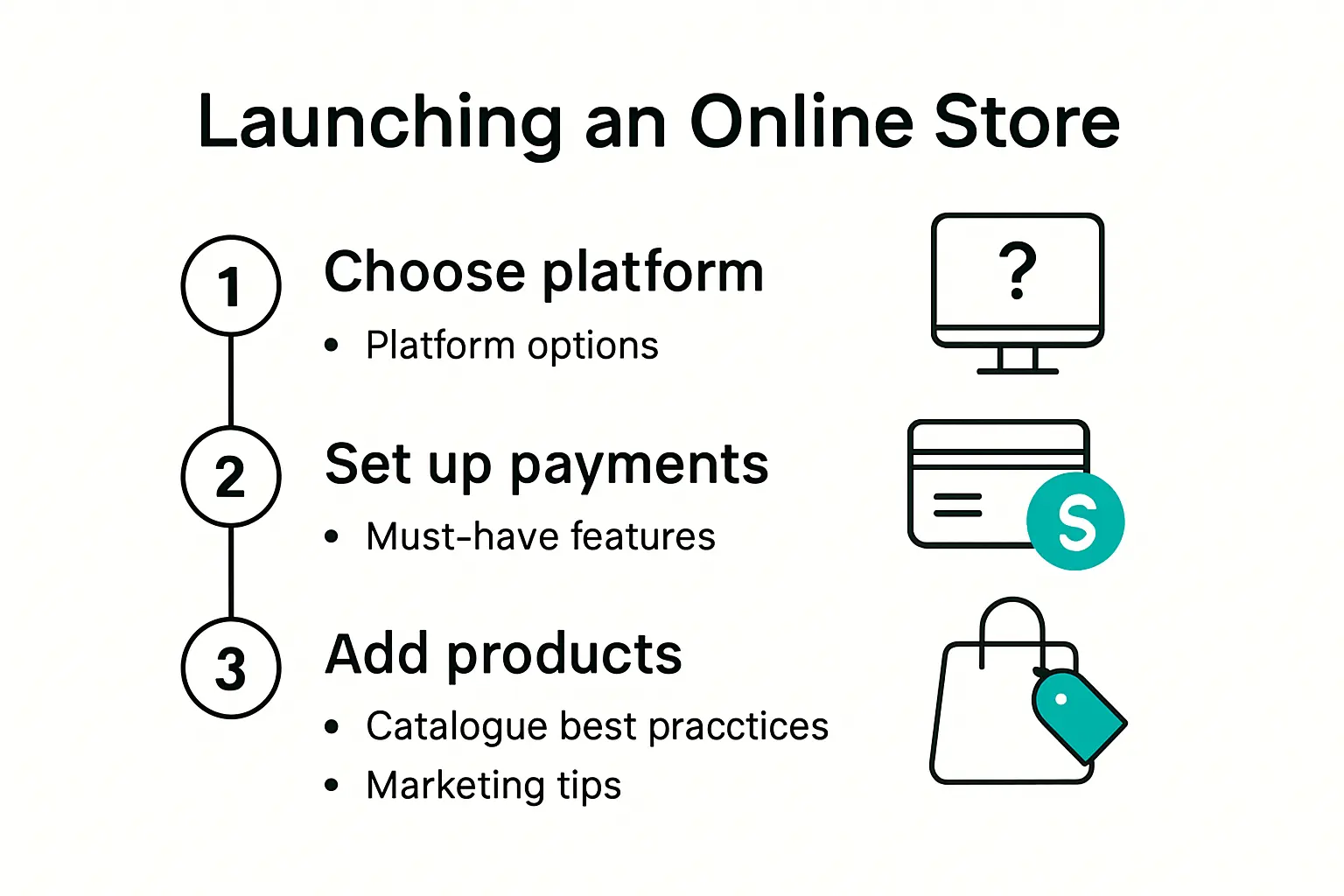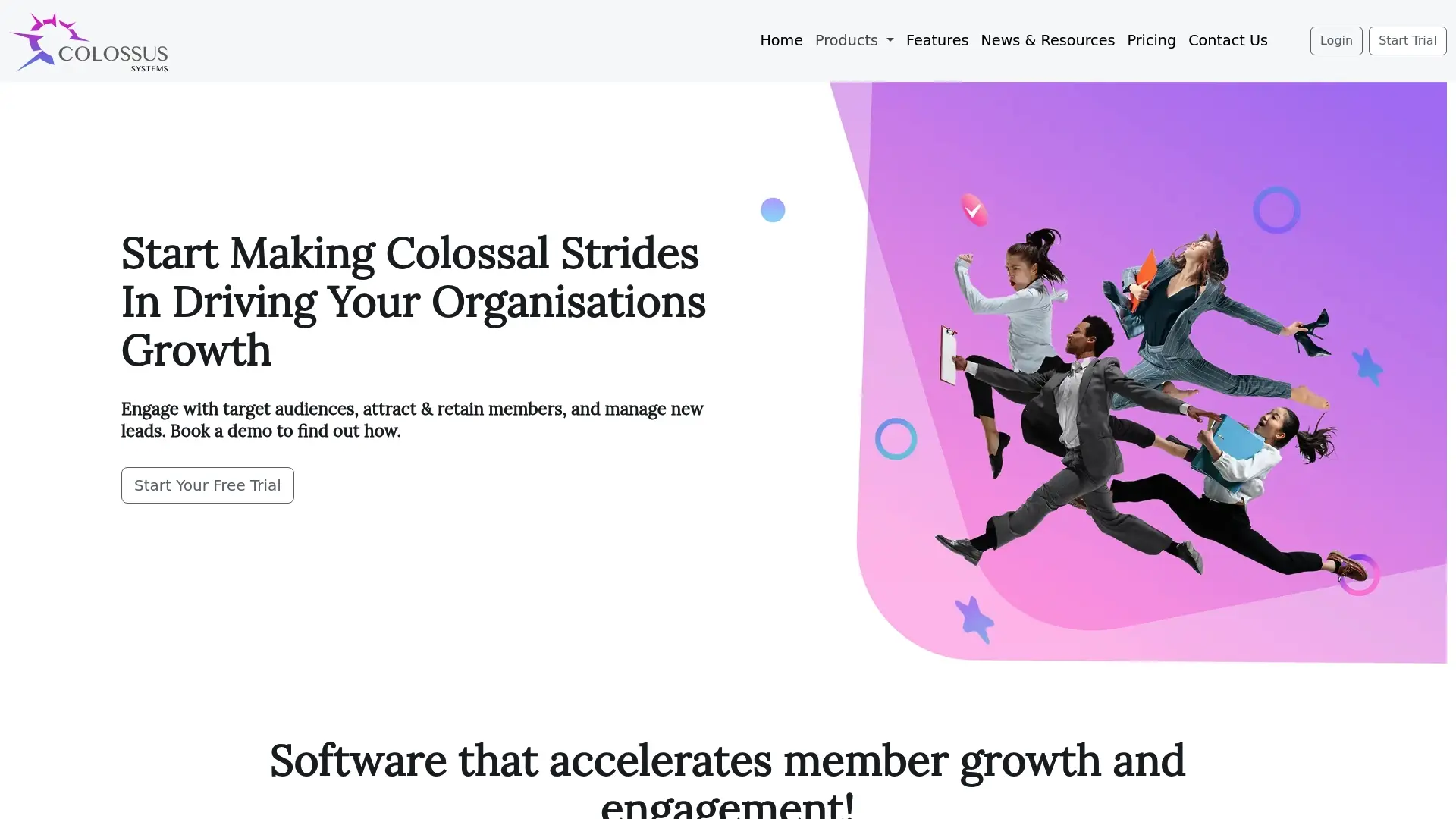Setting Up Online Stores for Membership Organisations in 2025

Membership organisations are tapping into new ways to serve their communities and increase income. Here is something unexpected. Organisations with online stores have seen their revenue climb by an average of 35 percent over traditional models. Yet profit is not even the most surprising advantage these digital shops bring. The real twist is how a simple storefront can transform member loyalty and engagement, changing the way people connect to your cause.
Table of Contents
- Key Benefits Of Online Stores For Organisations
- Step-By-Step Setup For Your Organisation’s Online Store
- Choosing The Best Platform And Payment Options
- Promoting And Managing Your Online Store Effectively
Quick Summary
| Takeaway | Explanation |
|---|---|
| Implement online stores for diverse revenue streams | Online stores can increase revenue by 35% through direct member sales of goods and services. |
| Enhance member engagement with tailored offerings | Curated product catalogues improve member experiences, ensuring relevant resources are easily accessible. |
| Choose the right platform and secure payment options | Evaluate e-commerce platforms for scalability and integrate secure payment methods to protect transactions. |
| Utilise strategic marketing for store promotion | Use existing communication channels to highlight new offerings and encourage member participation in your online store. |
| Continuously monitor and refine digital storefront | Regularly assess performance metrics and member feedback to adapt your strategy and enhance the online shopping experience. |
Key Benefits of Online Stores for Organisations
Setting up online stores for membership organisations presents transformative opportunities for growth, engagement, and financial sustainability. By leveraging digital commerce platforms, organisations can unlock strategic advantages that extend far beyond traditional revenue models.
Revenue Generation and Diversification
Online stores provide membership organisations with robust mechanisms for generating additional income streams. Research from the Digital Commerce Association indicates that organisations with integrated e-commerce platforms experience an average revenue increase of 35% compared to traditional membership models. These digital marketplaces enable members to purchase merchandise, training materials, event tickets, and specialised resources directly through the platform.
The financial benefits are multifaceted. Digital stores eliminate significant overhead costs associated with physical retail spaces, reduce transaction processing expenses, and create opportunities for automated sales. Members appreciate the convenience of purchasing directly through trusted organisational platforms, which increases customer loyalty and repeat transactions.
Enhanced Member Experience and Engagement
According to membership engagement research, online stores can significantly improve member interactions and perceived value. By offering curated product catalogues tailored to specific professional interests, organisations create personalised experiences that resonate with their community. Digital storefronts allow members to access resources anytime, anywhere, breaking traditional geographical and temporal constraints.
Moreover, these platforms facilitate seamless self-service capabilities. Members can independently browse, select, and purchase products without requiring direct staff intervention. This autonomy enhances user satisfaction and reduces administrative burdens for organisational staff. The ability to track purchase histories, recommend relevant products, and provide targeted communications further strengthens member relationships.
Strategic Operational Advantages
Beyond immediate financial gains, online stores offer strategic operational benefits. Digital commerce platforms provide comprehensive data analytics, enabling organisations to understand purchasing patterns, identify popular products, and make informed strategic decisions. Real-time inventory management, automated tax calculations, and integrated payment processing streamline complex administrative tasks.
Organisations can leverage these platforms to create tiered membership experiences, offering exclusive digital products or discounts to different membership levels. This approach not only generates additional revenue but also incentivises membership upgrades and long-term engagement. The scalability of online stores means organisations can rapidly expand their digital offerings without significant infrastructure investments.
By embracing digital commerce, membership organisations transform from traditional membership models to dynamic, member-centric ecosystems that prioritise convenience, value, and continuous engagement. The strategic implementation of online stores represents a forward-thinking approach to organisational sustainability and growth.
To provide a clear overview, the following table summarises the key benefits of setting up online stores for membership organisations as described above.
| Benefit Area | Key Advantages |
|---|---|
| Revenue Generation and Diversification | 35% average revenue increase, reduced overhead, automated sales |
| Enhanced Member Experience and Engagement | Personalised catalogues, self-service, anytime/anywhere access |
| Strategic Operational Advantages | Data analytics, real-time inventory, tiered pricing, scalability |
| Member Loyalty and Retention | Convenience, exclusive offers, targeted communications |
Step-by-Step Setup for Your Organisation’s Online Store
Establishing an online store for your membership organisation requires careful planning and strategic execution. This comprehensive guide will walk through the essential steps to create a robust and effective digital marketplace that serves your members and supports your organisational goals.

Platform Selection and Initial Preparation
The U.S. Chamber of Commerce recommends beginning with a thorough assessment of your organisation’s specific needs and technological capabilities. Start by evaluating your current technological infrastructure and identifying the specific products or services you plan to offer through your online store.
Key considerations during platform selection include compatibility with existing membership management systems, scalability, payment processing capabilities, and ease of use. Look for e-commerce solutions that offer integrated membership management features, allowing seamless connection between store transactions and member profiles. Consider factors such as transaction fees, customization options, and integration potential with your existing digital ecosystem.
Technical Implementation and Payment Setup
According to the International Costumer’s Guild, setting up secure payment systems is crucial for membership organisations. Select payment gateways that offer competitive rates for nonprofit and membership-based groups. Prioritize platforms that provide:
- Secure Transaction Processing: Ensure PCI compliance and robust encryption
- Multiple Payment Options: Credit cards, digital wallets, bank transfers
- Membership-Specific Features: Automatic renewal options, tiered pricing
Implement a comprehensive testing phase to verify all technical components function smoothly. This includes checking product listings, payment flows, tax calculations, and integration with your membership database. Create test transactions to validate the entire purchase experience from a member’s perspective.
Product Catalogue and Marketing Strategy
Zeffy’s nonprofit guide emphasizes the importance of curating a compelling product catalogue that provides genuine value to your members. Develop a strategic approach to product selection that aligns with your organisation’s mission and member interests.
Organise your digital storefront with clear categorisation, high-quality product images, detailed descriptions, and transparent pricing. Consider offering exclusive member discounts, bundled packages, or limited-edition items that create additional incentives for membership engagement. Implement analytics tracking to monitor product performance and member purchasing behaviour.
Develop a targeted marketing strategy to promote your new online store. Utilize existing communication channels such as email newsletters, member portals, and social media platforms to announce the launch and highlight unique offerings. Create instructional content that helps members navigate the new digital marketplace and understand its benefits.
Remember that launching an online store is an iterative process. Continuously gather member feedback, monitor performance metrics, and be prepared to adapt your approach. Successful digital stores evolve through ongoing refinement and a commitment to meeting the changing needs of your membership community.
Below is a process table outlining the main steps involved in setting up an online store for a membership organisation, based on the guidance provided in this section.
| Step | Description |
|---|---|
| Assess Needs & Infrastructure | Review current systems and define products/services for sale |
| Choose E-commerce Platform | Evaluate for compatibility, scalability, integration with membership management |
| Setup Payment Solutions | Implement secure gateways with relevant payment and membership features |
| Build and Test Storefront | Populate listings, configure tax/shipping, run test transactions to ensure smooth flow |
| Launch & Market Store | Announce launch, promote through existing channels, educate members |
| Monitor & Refine | Collect feedback, track analytics, update offerings and improve experience |
Choosing the Best Platform and Payment Options
Selecting the appropriate e-commerce platform and payment solutions is critical for membership organisations seeking to establish a robust online store. The right technological infrastructure can significantly impact member experience, financial performance, and organisational efficiency.
E-commerce Platform Evaluation
The U.S. Government Accountability Office recommends a comprehensive approach to digital platform selection. Organisations must assess platforms based on multiple critical dimensions beyond basic transactional capabilities. Key evaluation criteria include scalability, integration potential with existing membership management systems, customization flexibility, and comprehensive reporting features.
Consider platforms that offer specialised features for membership organisations, such as tiered pricing structures, automated membership renewal options, and granular access controls. Look for solutions that provide intuitive user interfaces for both administrators and members, ensuring smooth navigation and minimal friction during purchasing processes. Prioritize platforms with robust API capabilities that allow seamless integration with your existing technological ecosystem.
Security and Compliance Considerations
NIST Special Publication 800-211 emphasizes the paramount importance of payment processing security for digital commerce platforms. When evaluating payment options, organisations must prioritize providers that demonstrate comprehensive security protocols, including:
- Data Encryption: Advanced encryption standards protecting member financial information
- PCI DSS Compliance: Adherence to Payment Card Industry Data Security Standards
- Fraud Detection: Integrated mechanisms for identifying and preventing unauthorized transactions
- Multi-Factor Authentication: Enhanced login and transaction verification processes
Additionally, consider payment providers offering specialised rates or services for nonprofit and membership-based organisations. Some processors provide reduced transaction fees, dedicated support channels, and tailored financial reporting tools that can significantly optimise your organisation’s digital commerce strategy.
Payment Method Diversity and User Experience
Modern membership organisations must offer diverse payment options to accommodate varying member preferences and technological comfort levels. Beyond traditional credit card processing, consider integrating alternative payment methods such as digital wallets, bank transfers, and recurring billing mechanisms.
Evaluate payment solutions that support international transactions if your organisation has a global membership base. Look for platforms enabling multi-currency processing, automatic tax calculations, and localized payment interfaces. The goal is to create a frictionless purchasing experience that reduces barriers to membership engagement and product acquisition.
Remember that platform and payment selection is not a one-time decision but an ongoing strategic process. Regularly review your technological infrastructure, monitor member feedback, and remain adaptable to emerging digital commerce trends. By maintaining a proactive approach to platform management, your organisation can create a dynamic, secure, and member-centric online store that drives engagement and supports long-term organisational growth.
Promoting and Managing Your Online Store Effectively
Successful online stores for membership organisations require strategic promotion and ongoing management to drive engagement, revenue, and member satisfaction. Developing a comprehensive approach that combines marketing techniques, content strategy, and continuous improvement is essential for digital marketplace success.
Marketing and Visibility Strategies
According to American Eagle’s digital insights, effective e-commerce promotion demands a multifaceted approach. Begin by leveraging existing communication channels such as email newsletters, member portals, and social media platforms to announce new product offerings and highlight exclusive member benefits.
Create targeted marketing campaigns that showcase the unique value of your digital store. Develop compelling content that demonstrates how products and services directly contribute to professional development, networking opportunities, or organisational mission. Implement segmentation strategies to deliver personalised product recommendations based on member profiles, interests, and historical purchasing behaviour.
Content and User Experience Optimization
The Chambers of Commerce resource emphasizes the critical importance of user experience in driving online store success. Design an intuitive, visually appealing storefront that simplifies product discovery and purchasing processes. Invest in high-quality product imagery, detailed descriptions, and clear pricing information to build member trust and confidence.
Develop a robust content strategy that extends beyond product listings. Create supplementary resources such as buying guides, member testimonials, and educational content that adds value to your digital marketplace. Consider learning more about engagement strategies to enhance member interaction and retention.
Performance Monitoring and Continuous Improvement
Morweb’s membership website guide highlights the importance of ongoing performance analysis. Implement comprehensive analytics tracking to monitor key metrics such as:
- Conversion Rates: Percentage of visitors completing purchases
- Average Order Value: Total revenue per transaction
- Product Performance: Most and least popular items
- Member Engagement: Frequency of purchases and interaction
Regularly solicit member feedback through surveys, focus groups, and direct communication channels. Use these insights to refine your product offerings, improve user experience, and address potential pain points. Maintain flexibility in your approach, being prepared to adapt your strategy based on changing member needs and technological advancements.
Successful online store management is an iterative process that requires consistent attention, strategic thinking, and a member-centric approach. By combining sophisticated marketing techniques, user-friendly design, and data-driven decision-making, membership organisations can create digital marketplaces that not only generate revenue but also strengthen member relationships and organisational value.

Frequently Asked Questions
What are the benefits of setting up an online store for a membership organisation?
Implementing an online store can increase revenue by 35% through direct member sales, enhance member engagement with tailored offerings, and provide strategic operational advantages like data analytics and inventory management.
How can an online store improve the member experience?
An online store enhances the member experience by offering a curated product catalogue tailored to their interests, allowing for self-service capabilities, and providing access to resources anytime, anywhere, which leads to greater satisfaction and reduced administrative burdens.
What should organisations consider when choosing an e-commerce platform?
When selecting an e-commerce platform, organisations should evaluate scalability, integration with existing membership systems, customisation options, and user-friendliness, ensuring the platform meets specific needs for their membership model.
How can membership organisations effectively promote their online store?
Membership organisations can promote their online store by leveraging existing communication channels such as email newsletters and social media, creating targeted marketing campaigns, and developing valuable content that highlights the benefits of their digital offerings.
Ready to Unleash the Full Potential of Your Online Store?
Building an online store for your membership organisation can be overwhelming. The article has shown how digital commerce is no longer optional for driving growth in 2025. Yet, many organisations struggle to connect all the pieces. Difficulties with secure payment, platform integration, and engaging member experiences are common. Without a seamless system, you risk missing out on the 35 per cent increase in revenue and member loyalty that other modern organisations are already enjoying.

Why wait to transform the way your members interact with you? Colossus Systems gives you everything from unified e-commerce and secure payments to centralised member management in one easy platform. Personalise your storefront, automate events, and offer exclusive resources without juggling multiple tools. Visit Colossus Systems now and see how our solutions for membership management and digital engagement can help you launch a truly successful online store today.